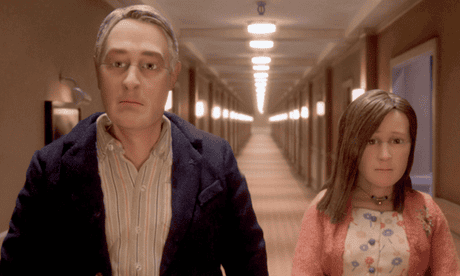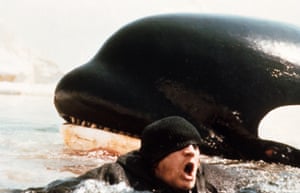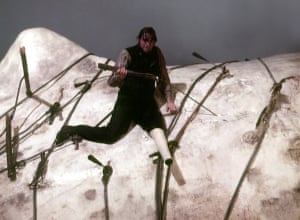Film
Thar she blows! Cinema's most spectacular whale hunts
From John Huston’s blood-drenched Moby Dick to Richard Harris’s orca epiphany, cinema has always loved a whale hunt. Will In the Heart of the Sea land the big one?

Tail of doom … Ron Howard’s In the Heart of the Sea. Photograph: Warner Bros
Philip Hoare
Sunday 6 December 2015
From Pinocchio to Free Willy, from Whale Rider to Blackfish, cinema has frequently dallied with what the whale might, or might not, mean. In 1943, Walt Disney even turned Nazi Germany into a fearsome animated whale about to swallow plucky Britain. But above them all looms one legendary beast: the great white whale, Moby-Dick, freighted with portentous doom.
Ron Howard’s imminent action movie, In the Heart of the Sea, based on the bestselling book by Nathaniel Philbrick, follows the fate of the Essex, a Nantucket whaleship sunk by a sperm whale in the Pacific in 1820, and the terrible consequences that ensued. It was this same story that Herman Melville used for his 1851 epic novel, thereby turning reality into literary legend.
Howard’s movie – starring Chris Hemsworth, Cillian Murphy, Tom Holland and Ben Whishaw – was due for release last March. Its delay is rumoured to be a result of high expectations for Oscar nominations. It’s certainly a lavish production, and a rip-roaring ride. The opening scenes gloriously recreate the New England island of Nantucket, where modern whaling began and where Melville, played by Whishaw, is told the story of the Essex by a surviving crewman.
But it is also a retelling of a foundation myth. Just as the western film and literary genre was a tribute to the conquest of the American wilderness on land, so Melville’s Moby-Dick was its oceanic equivalent. Read whales for buffalos, and whale oil for mineral oil, and the importance of whaling to the US becomes clear. Whale ships were the oil tankers of their day, and they exported American culture over the oceans – just as Hollywood would export Americanness via the western. Violence, glamour, heroism and a Manichean notion of good and evil pervade both these eruptions of New World endeavour.
Melville’s book is close to my heart, as it is for anyone who has made it through its 136 chapters. Yet in some ways, I have to admit – as a self-confessed whalehead – that Moby-Dick perverted our relationship with cetaceans. It did for the whale what Peter Benchley, the author of Jaws, and Steven Spielberg did for the great white shark a century later. In 1977, three years after the immense success of Spielberg’s movie, Orca was released. In the film, produced by Dino de Laurentiis, the whale takes on the role of the shark, with the tagline: “The killer whale! The only animal other than man who kills for revenge.”
Facebook Twitter Pinterest Richard Harris in Orca. Photograph: Allstar/Paramount
Tellingly, however, Orca is more consistent with modern attitudes: at its climax, the pursuer – the derring-do Richard Harris – experiences an epiphany of pity towards the intelligent creature he now finds he cannot kill. Cinema was reflecting an elemental change. In the 1970s, the Save the Whales campaigns by Greenpeace and Friends of the Earth had turned the ocean giants into symbols in the fight to protect the environment.
Subsequent whale films followed that plotline. In 2002, Whale Rider evoked the creation myth of the Maori, which says they arrived in New Zealand on the backs of whales. And the Free Willy films showed a new awareness of the terrible fate of captive cetaceans – a sentiment the powerful 2013 documentary Blackfish rammed home. Using extraordinary footage, Blackfish examined the treatment of performing whales at SeaWorld in Florida, focusing on Tilikum, an orca that has been involved in the deaths of three people.
Yet the adrenaline of the whale hunt has proved irresistible to film-makers. In 1922, the silent movie Down to the Sea in Ships had the benefit of filming on the Charles Morgan, the last Yankee whaleship still at sea. Less splendid, to modern eyes, are the scenes of real whales being killed in its hunting scenes. (None of your “No animals were harmed in the making of this film” back then).
Watch the trailer for In the Heart of the Sea
In 2008, I used excerpts from the film in a feature-length BBC Arena documentary, The Hunt for Moby-Dick. It was hard to sit in the cutting room and watch these scenes of slaughter: the flickering black and white footage failed to disguise the butchery of sentient animals quivering as harpoons were plunged into their flanks. It’s a cetacean snuff movie I’d rather not see again.
In the Heart of the Sea is the latest update in this often sad and shameful story. The fate of the Essex was a terrifying episode. The whaleship, having come upon sperm whales thousands of miles from land, set about harpooning the pod. As the crew did so, an enraged 80ft-long bull charged at the ship. Then it turned round and did it again.
The Essex sank, leaving the crew of 20 to escape in their whaleboats. Ironically, they decided not to sail towards the nearest land, the Marquesas Islands, believing the inhabitants to be cannibals. Within weeks, the starving crew were forced to eat one another. Only three survived – so crazed that, when they were rescued, they declined to give up the human bones on which they were sucking.
These scenes are convincingly portrayed in Howard’s film. Earlier this year, Cillian Murphy told me how he, Hemsworth and Holland spent the first half of filming learning to row, getting muscular in the process. “It was a bit of a waste,” he said, “since we never took our shirts off.” More gruelling were the crash diets to achieve the hollow-eyed look required for later scenes. A dietician was on hand to regulate their weight loss, says Murphy, “but boys being boys, it all got competitive, and some of the cast would fast all day to get their weight down”.
Facebook Twitter Pinterest Gregory Peck as Ahab has his final battle with the white whale in Moby-Dick, 1956. Photograph: Everett Collection/Rex
Compared with the making of John Huston’s 1956 classic, Moby Dick, the tribulations suffered by Howard’s cast pale like the whiteness of the whale. For the location shooting, Huston requisitioned the Hispaniola – the ship previously used in Disney’s Treasure Island – and sailed it to Youghal in Ireland. There it was turned into Ahab’s Pequod, a ship tricked out in the very bones of its foe, with a whale jaw for its tiller. Huston even sourced original harpoons from the long-forgotten lofts of ship chandlers who’d worked in the Yorkshire whaling port of Hull.
Keeping orcas captive demeans us as humans
Philip Hoare
http://www.theguardian.com/film/2015/dec/06/whales-movies-heart-sea-moby-dick-blackfish-ron-howard-chris-hemsworth-cillian-murphy-tom-holland-ben-whishaw
Gregory Peck played the demonic Ahab with a lightning-scarred face and a white streak in his hair, and the crew were sent on their way with a stirring sermon on Jonah delivered by Orson Welles. Performing from a pulpit shaped like a ship’s prow, Welles sustained his cameo by drinking an entire bottle of bourbon stashed inside the prop.
The whale, created by model-makers, included a life-size section to which the long-suffering Peck was lashed in the final scenes, dunked in the water so many times, as Huston ordered take after take, that he nearly drowned. Another giant model whale they were using is said to have drifted into the Irish Sea: the RAF had to be called out to hunt it down as a danger to shipping.
Facebook Twitter Pinterest Watch a clip from Blackfish
The results now look primitive. Howard’s CGI whales are much more believable, if somewhat oversized and forthcoming (the real animals are shy to the point of timidity, as I can personally attest). But Huston’s film lodges in the memory because of its herculean ambitions. He made it at a time when whale culling was at its height, powered by grenade harpoons and factory ships.
A recent assessment by Robert Rocha of the New Bedford Whaling Museum in Massachusetts revealed that 3 million whales were killed during the 20th century. Huston, who commissioned the filming of a real whale hunt off Madeira and used the bloody scenes in his movie, may have added to that toll. More whales died in the single year that his film was made than in a century and a half of the Yankee whaling commemorated by Melville. The reconciliatory ending of In the Heart of the Sea – without giving too much away – echoes a tectonic shift in our attitudes to the natural world. I suppose for that, the film’s true star, the whale, should be grateful.
In the Heart of the Sea is released on 26 December. Leviathan or the Whale by Philip Hoare is published by Fourth Estate. Buy it at bookshop.theguardian.com or call 0330 333 6846



No comments:
Post a Comment